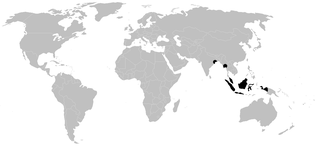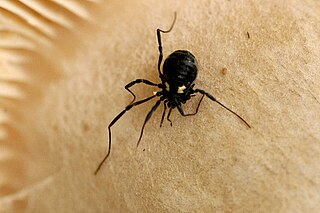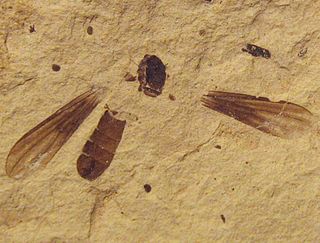
The Opiliones are an order of arachnids colloquially known as harvestmen, harvesters, or daddy longlegs. As of April 2017, over 6,650 species of harvestmen have been discovered worldwide, although the total number of extant species may exceed 10,000. The order Opiliones includes five suborders: Cyphophthalmi, Eupnoi, Dyspnoi, Laniatores, and Tetrophthalmi, which were named in 2014.

Archaeidae, also known as assassin spiders and pelican spiders, is a spider family with about ninety described species in five genera. It contains small spiders, ranging from 2 to 8 millimetres long, that prey exclusively on other spiders. They are unusual in that they have "necks", ranging from long and slender to short and fat. The name "pelican spider" refers to these elongated jaws and necks used to catch their prey. Living species of Archaeidae occur in South Africa, Madagascar and Australia, with the sister family Mecysmaucheniidae occurring in southern South America and New Zealand.

Dicranopalpus ramosus is a species of harvestman. Males are up to 4 mm long, females can reach up to 6 mm. Both sexes have very long legs, with a distinct elongated apophysis that reaches almost to the end of the tibia. This makes their pedipalps look forked. Their body is brownish with dark markings, the females being lighter colored.

The Eupnoi are a suborder of harvestmen, with more than 200 genera, and about 1,700 described species.

Cyphophthalmi is a suborder of harvestmen, colloquially known as mite harvestmen. Cyphophthalmi comprises 36 genera, and more than two hundred described species. The six families are currently grouped into three infraorders: the Boreophthalmi, Scopulophthalmi, and Sternophthalmi.

The Phalangiidae are a family of harvestmen with about 380 known species. The best known is Phalangium opilio. Dicranopalpus ramosus is an invasive species in Europe.

Sabaconidae is a family of harvestmen with 57 described species in one genus, Sabacon, which is found throughout the Northern Hemisphere.

Sabacon is a genus of the harvestman family Sabaconidae with about forty species.

The Sironidae are a family of harvestmen with more than 30 described species.

The Stylocellidae are a family of harvestmen with about 30 described species, all of which occur from India to New Guinea. Members of this family are from one to seven millimeters long. While Stylocellus species have eyes, these are absent in the other two genera.

The Nemastomatidae are a family of harvestmen with about 170 described species in 16 recent genera. Several fossil species and genera are known.

Samoidae is a family of the harvestman infraorder Grassatores with about fifty described species.

The Cladonychiidae are a small family of harvestman with about 33 described species, within the suborder Laniatores.

The Baltic region is home to the largest known deposit of amber, called Baltic amber or succinite. It dates from 44 million years ago. It has been estimated that these forests created more than 100,000 tons of amber. Today, more than 90% of the world's amber comes from Kaliningrad Oblast of Russia. It is a major source of income for the region; the local Kaliningrad Amber Combine extracted 250 tonnes of it in 2014, 400 tonnes in 2015.

Palaeovespa is an extinct genus of wasp in the Vespidae subfamily Vespinae. The genus currently contains eight species, five from the Priabonian stage Florissant Formation in Colorado, United States two from the middle Eocene Baltic amber deposits of Europe. and one species from the late Paleocene of France.

Diochus electrus is an extinct species of rove beetle in genus Diochus, the only definitive fossil species in subfamily Staphylininae. The species is known only from the middle Eocene, Lutetian stage Baltic amber found in the Blaue Erde deposits, Baltic region, Northern Europe.

Metanephrocerus is an extinct genus of big-headed flies in the dipteran subfamily Protonephrocerinae, for which it is one of only two genera. The genus contains four described species, Metanephrocerus belgardeae, M. collini, M. groehni, and M. hoffeinsorum. Metanephrocerus is known from a group of Middle Eocene fossils which were found in Europe and a single early Eocene fossil from North America.

Archaea is an extinct genus of spiders in the family Archaeidae. As of October 2016, four species are placed in the genus. All have been found preserved in amber, either from the Baltic or Bitterfeld, Germany. First described in 1854, Archaea species have a distinctive "neck" separating the head from the thorax, and very long chelicerae ("jaws").
This list of fossil arthropods described in 2012 is a list of new taxa of trilobites, fossil insects, crustaceans, arachnids and other fossil arthropods of every kind that have been described during the year 2012. The list only includes taxa at the level of genus or species.
Nemastomatinae is a subfamily of harvestmen with 123 described species in 18 genera.















